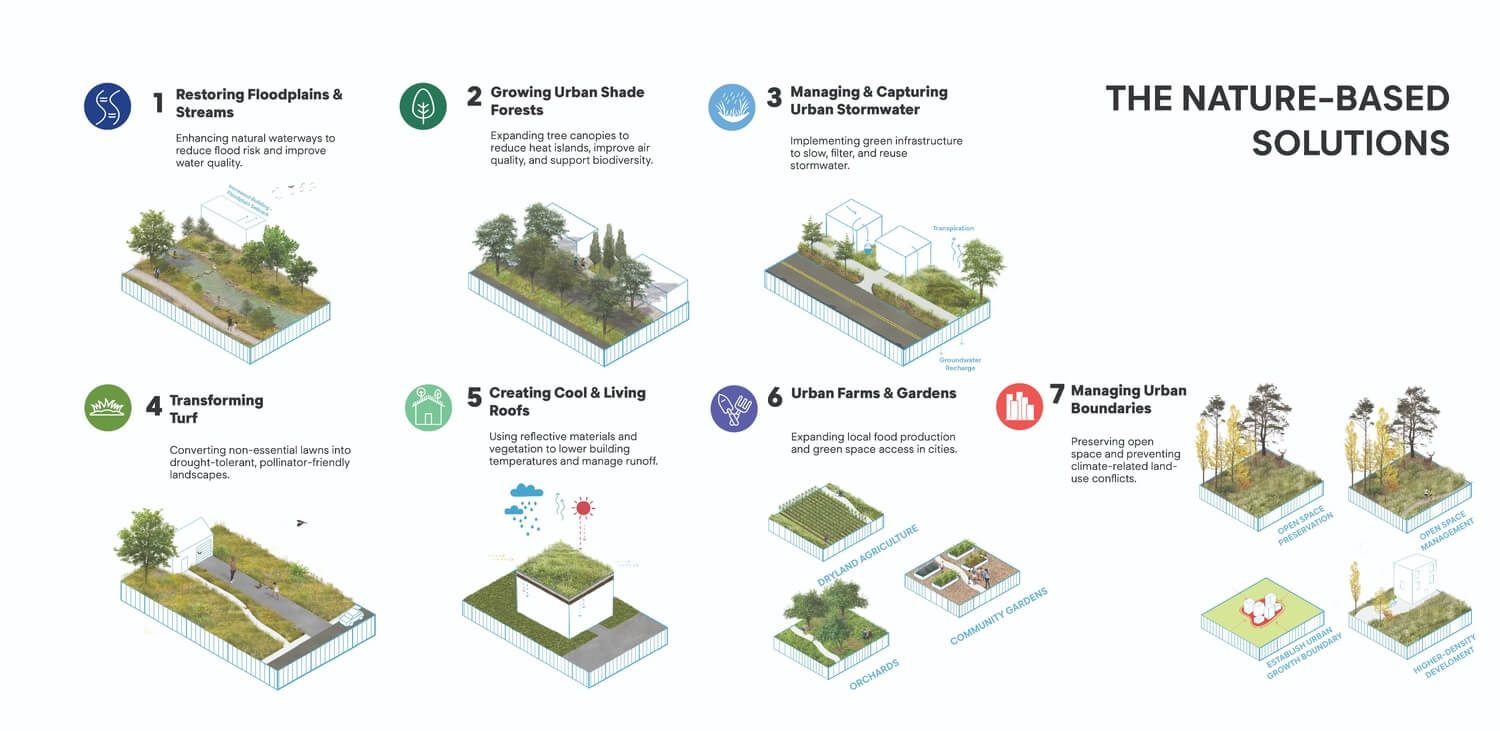Boulder County sits where the Rockies meet the Great Plains. To the west, the Front Range rises with Longs Peak towering over forests, lakes, and meadows. These mountains ease into the Flatirons and rolling foothills, blending into the grasslands. Eastward, the land flattens into farmland and towns like Longmont and Lafayette. With a population of over 300,000 and elevations ranging from 5,00 to 14,000 feet, Boulder County offers a striking mix of diverse landscapes and densely developed urban centers making their need for local climate-responsive solutions paramount.
In recent years, the county has experienced the intensifying impacts of climate change. On December 30, 2021, the Marshall Fire, fueled by extreme winds and prolonged drought conditions, erupted in Boulder County. The fire destroyed over 1,000 homes, becoming the most destructive wildfire in Colorado’s history. In response, the Boulder County Office of Sustainability, Climate Action, and Resilience (OSCAR) launched a groundbreaking initiative in April. In collaboration with the Denver-based landscape architecture firm Superbloom, the county released Designing Resilient Urban Landscapes: Nature-Based Solutions for Local Governments—a toolkit aimed at helping municipalities turn the corner on climate planning. The document outlines locally tailored, science-backed strategies for using green infrastructure to reduce carbon emissions and boost community resilience.
From microforests that grow ten times faster than conventional plantings to fire-resistant landscaping and water-wise urban farms, the toolkit identifies high-impact interventions specific to Boulder County’s varied topography, ranging from alpine to prairie. The goal was both ambitious and pragmatic: to embed nature into urban life in ways that mitigate risks from wildfire, drought, extreme heat, and flooding.
Taking on Resiliency
In the development of this project, Boulder County officials were specifically looking for nature-based solutions to combat potential climate risks in the area. But while national interest in nature-based solutions has grown rapidly, OSCAR found that many existing frameworks, especially those shaped by waterfront cities like New York, felt disconnected from Colorado’s arid, high-altitude conditions.
OSCAR needed a firm with the capacity to research the solutions and their efficacy, with knowledge of Boulder County’s varied landscape, with experience implementing nature-based solutions in urban areas, and with the ability to package the enormous amount of information in a visually compelling and easily accessible way. This usually isn’t a job for a landscape architecture firm, but Superbloom doesn’t shy away from challenging work.
“OSCAR was very surprised when they got us, a landscape architecture firm, as an applicant for this project,” Stacy Passmore, cofounder of Superbloom told AN. “The others that applied were from very different fields, more business or data mapping, firms with specific online software.”
Superbloom Steps In
Founded in 2021 by Stacy Passmore and Diane Lipovsky, Superbloom is known for projects like the restoration of Warm Springs Preserve and the landscape design for Denver’s Populus Hotel. But the Boulder County resiliency toolkit marked a new venture into large-scale planning and policy work. The resiliency plan is a roadmap for governments to imagine and implement climate-forward landscapes with potential to become a model for other regions in the Intermountain West.

“The idea of impact was really important to us,” Passmore said. “And, so, sometimes we end up pursuing projects that are a little more interdisciplinary and transdisciplinary.
Superbloom’s process blended research, community engagement, and policy analysis. The firm interviewed regional experts and stakeholders to rank the most impactful solutions. They also flagged potential trade-offs. Green roofs, for example, offer biodiversity and cooling benefits but can increase wildfire risk or require unsustainable irrigation in certain zones.
“Superbloom brings both the high level, aspirational graphic component to the project and the wealth of experience of having to actually build these things,” Lipovsky told AN. “We’re intimately aware of how every little piece of that proposed small green roof costs. We are coming from both sides, our knowledge and experience is folded into this toolkit.”
The county is already putting that principle into practice. A forthcoming grant program will fund pilot projects across Boulder’s municipalities, with equity as a key selection criterion. Maps showing impervious surfaces, flood vulnerability, and urban heat islands will guide where funds go first.
Politics Versus Policy
In a political climate where federal support for climate policy is increasingly uncertain, local solutions, like the toolkit, are becoming more and more important.“Landscapes do not know political boundaries,” Lipovsky said.

After the project began in 2024, Lipovsky noticed that certain citations and studies used to inform Superbloom’s approach, originally published by federally funded agencies like NOAA and FEMA, were disappearing from public access.
“This was extra motivating,” Lipovitsky said. “I felt like we needed to get this information out there before everything disappears. And in that way this project is super timely.”
Passmore and Lipovsky see this as part of a larger movement—one that’s local, tangible, and quietly revolutionary. Through their work on the toolkit, they’ve encountered concern for the environment among Colorado residents across the political spectrum, with support for these initiatives often rooted in personal experiences with increasingly extreme weather in recent years. This had led to widespread change in the state of Colorado and more planning work for Superbloom as it is now leading efforts to overhaul Denver’s zoning code in response to a new statewide ban on nonfunctional turf.
As climate challenges grow more complex and urgent, Superbloom’s work in Boulder County offers a hopeful vision for the future of landscape architecture. A future rooted in place, powered by community, and committed to equity. From pilot projects in Boulder to zoning reforms in Denver, the firm is proving that landscape architects can do more than design spaces—they can shape policy, guide resilience planning, and mobilize change at every scale.
→ Continue reading at The Architect's Newspaper
